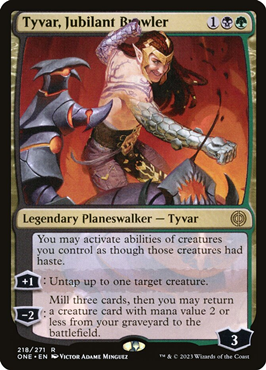With March of the Machine and its Aftermath now both revealed, 2023 looks very much like the end of an era for Magic’s Planeswalkers. Many were casualties of the struggle against Phyrexia, including some who lost their spark and were demoted to mere legendary creatures.
But even the survivors can tell their role in the multiverse has changed. In fact, the role of Planeswalker cards — and the template for designing them — has been changing for a while…
THE LITTLE ENGINES THAT COULD
At their simplest, Planeswalkers are cards that win by maintaining on-board parity. The biggest hitch in this game plan is you need to sink at least a turn’s worth of mana into deploying them, which often costs you that parity since they are usually not efficient at self-defense.


But over time, the average cost of Planeswalkers has decreased, making it more common for them to hit play on turn three (or sooner). That cost reduction makes it less likely your opponent will have built a board state that can punish a Planeswalker when played on-curve. Or later in games, it gives you the chance to cast a second spell in the same turn to keep the walker safe.


The big shift toward three-mana Planeswalkers came around 2019. Wizards of the Coast was clearly experimenting with the card type’s boundaries, and the result was a string of notoriously broken, bannable cards that made Planeswalker design a hot-button issue.
The cheaper casting costs became central to this discussion, since they were the most obvious change from earlier, safer Planeswalkers. But even at the time, I wrote an article to argue that it wasn’t the only issue.


If you don’t have a couple of minutes to read that, I’ll summarize: having a high “floor” for the value of their first activation is far more important to a Planeswalker’s playability than anything else.
The most oppressive Planeswalkers are the ones like Oko and Teferi, which can defend themselves in a way that also generates lasting value, rather than choosing between the guaranteed value and a greedier attempt at keeping them alive on a contested board.
If you want a more current example, Minsc & Boo, Timeless Heroes has become a massive threat in Legacy thanks to a similar, no-downsides play pattern. One uptick leaves you with a 4/4 hamster and a four-loyalty Planeswalker.
Killing both in one turn is rarely possible. Killing just one feels mediocre. Not killing either one is essentially a death sentence.
CREATING PUZZLES PLAYERS WANT TO SOLVE
We can see broadly the same design problem recurring across these troubled Planeswalkers — they present a very boring “subgame.”
Planeswalkers are very unique in their play patterns; they offer a choice of abilities, but the timing and loyalty limitations make things much more predictable. This is important, because your opponent can also potentially control what your Planeswalker does by attacking its loyalty or limiting its targets for certain abilities.
Just like Battles, Planeswalkers shrink the strategic projection of both players from the somewhat-abstract goal of dealing 20 damage down to a much more immediate four or five damage on a specific permanent. Each Planeswalker offers its own unique version of this “subgame” within the larger game, as defined by how its different ability combinations affect the board state and its own loyalty.
A well-designed Planeswalker has a subgame that leaves room for the opponent to reasonably affect the outcomes, whether by killing the Planeswalker outright, knocking it down a few loyalty or denying it the chance to use certain abilities.
In some cases, even the choice of completely ignoring the Planeswalker can be a valid and exciting strategy — choosing to race their ultimate activation or just weather the worst they have to offer.


Compare that to Oko, Minsc & Boo or Nissa, Who Shakes the World. These subgames rarely set up interesting choices for either player to think about. The controlling player only has one option of how to activate them (or perhaps a couple of functionally similar options) and their opponent is essentially forced to throw everything at killing them immediately, while knowing it’s still a losing exchange, even if that works.
The good news is, Wizards seems to have pretty much got this figured out in 2023. Taking a look at the abilities of our most recent three-mana Planeswalkers, you can see how the subgames have been crafted to depend more on the game state, and to limit the Planeswalker’s overall role in a deck. All of that makes them more fun both to play and play against.
Wrenn and Realmbreaker
The choice to have the +1 ability neither untap the target land nor make it a creature permanently is an important limitation. Along with the choice to give her a traditional game-winning ultimate (no longer something automatic for Planeswalkers), it establishes this new Wrenn’s role.
This is a win condition you need to protect with other cards, including setting up blockers in advance, if you want to cast it curve. The +1 contributes to your board control a little bit, but not in a way that accumulates or leaves value behind should Wrenn die.
The -2 is a lovely little bit of utility, but it very much takes you off the already-slow plan to ultimate; something your opponent will also be aware of. So you’ll want Wrenn most as a backup to other late game bombs like Atraxa, Grand Unifier — cards she can help you find and cast when the game is moving too fast to reach her own ultimate.
Tyvar, Jubilant Brawler
Only having two loyalty abilities limits the possibilities for Tyvar’s subgame, but there’s still some very tricky decisions he creates for both players. His inability to directly impact the board is interesting for the opponent because it raises the question of whether a lonely Tyvar is even worth taking time to kill.
While they debate that choice, Tyvar’s controller has to weigh up the potential outcomes of his -2 based on at least partially unknown information.
Jace, the Perfected Mind
I’m including Jace since you can cast him for three mana plus two life, but it’s worth pointing out that this is already a wonderful wrinkle for the subgame, creating two distinct start points that significantly change what comes next.
Blue planeswalkers are usually pretty bad at defending themselves given their color’s relationship to creatures, so this will be another classic “protect the engine” type walker. As with Wrenn and Realmbreaker, the +1 here is pretty much just passing the turn while you charge your loyalty for the game-winning ability. But the relationship between Jace’s second and third abilities is quite different.
The -2 ability is Jace’s real “ultimate,” assuming you’ve reached the point where it draws you three(!) cards. The -X ability is only better in two situations: when you haven’t gotten 20 cards in a graveyard yet, and when you can use it to completely mill your opponent and end the game.
So assuming mill is your main win con, there’s a delicious tension between the two abilities. You’ll usually want to -2 as much as you can. But if you don’t desperately need to draw more gas, then it might be tempting to “bank” some of those activations and instead keep ticking Jace up, threatening to uncounterably mill a huge chunk of their deck.
Of course, that means you could then lose all your potential card draw to a top-decked removal spell…
I could go on and on with this, but maybe it’s better to let you think about other Planeswalker subgames yourself. The addition of Battles in March of the Machine means we now have even more of these self-enclosed decision trees embedded into the average game of Magic, with completely different rules of engagement and outcomes which can swing the entire match.
But I’m not at all worried, because it’s hard to imagine these early Battle designs doing anything so reckless as Wizards has already been trying out with Planeswalkers.
WEIRD PLANESWALKERS ARE GOOD PLANESWALKERS
Hot take alert: I’d argue that Planeswalker design has actually gotten much MORE wild and experimental since that 2019-20 danger period, especially in the last 6 months.
Just think about it! We’ve had:
- Planeswalkers you can’t attack
- Planeswalkers you can’t target
- Planeswalkers that put other Planeswalkers into play
- Planeswalkers that put extra copies of themselves into play (some of which can immediately ultimate!)
- Planeswalkers that give your other Planeswalkers new abilities
- Planeswalkers with Phyrexian mana costs
- Planeswalkers you can cast from the graveyard
- Planeswalkers you can cast in the middle of combat
- Planeswalkers you can only cast by winning combat
- Planeswalkers that gain loyalty from card draw, landfall, and creature death
- Two Planeswalkers printed on one card
- One Planeswalker printed on two cards
- And whatever alien design space Grist occupies…
That is an outburst of mechanical experimentation almost unprecedented in Magic’s history — and it doesn’t even touch on all the kooky stuff Wizards of the Coast has put on Planeswalkers not intended for Standard play.
But for all those forays into uncharted design space, the only serious balance debacle were combo decks abusing Tibalt, Cosmic Imposter. Even that was more to do with a loophole in the rules for double-faced cards that has since been fixed, and Valki/Tibalt is still an interesting and playable card when used fairly.
Maybe it’s just me, but it’s fascinating to see how little discussion or controversy these designs have evoked. It’s not just that people are overwhelmed by spoilers or that these cards aren’t seeing enough play to be worth talking about. Plenty of these oddballs have posted Standard results, with a few becoming absolute staples.
But even a card as successful and omnipresent as The Wandering Emperor shows huge strides in making focused, role-playing Planeswalker cards that still pack a punch. Her flash ability and powerful removal effect make it easier to stabilize with Emperor on the board. But, in turn, her lack of an ultimate and the loyalty cost of her token-making mean she’s not as dangerous from that position as say, Gideon, Ally of Zendikar would be.
No, I think Wizards has genuinely cracked the code on making viable-yet-fair Planeswalker cards. So as long as they stick by that method, they can make as many three-mana, weird-mechanic-blending monstrosities as they want.

Tom’s fate was sealed in 7th grade when his friend lent him a pile of commons to play Magic. He quickly picked up Boros and Orzhov decks in Ravnica block and has remained a staunch white magician ever since. A fan of all Constructed formats, he enjoys studying the history of the tournament meta. He specializes in midrange decks, especially Death & Taxes and Martyr Proc. One day, he swears he will win an MCQ with Evershrike. Ask him how at @AWanderingBard, or watch him stream Magic at twitch.tv/TheWanderingBard.







